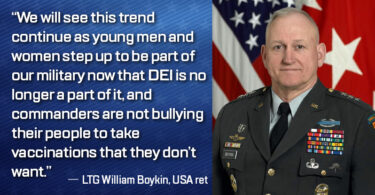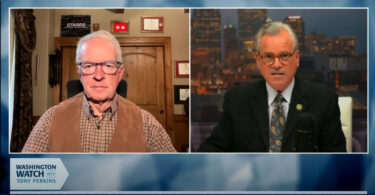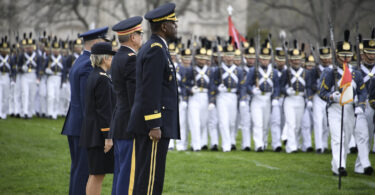Statement to DACODAI by leaders of Stand Together Against Racism and Radicalism in the Services (STARRS.US)
April 22, 2024
General Lester L. Lyles (USAF, Ret.)
Chairman Defense Advisory Committee on Diversity and Inclusion (DACODAI)
4800 Mark Center Drive, Suite 06E22
Alexandria, VA 22350
A copy of this letter has been sent CM-RRR and to the email address: osd.mc-alex.ousd-p-r.mbx.dacodai@mail.mil
Dear Chairman Lyles:
The undersigned write to you in accordance with an invitation to the general public to provide input to the DACODAI for its May 2-3, 2024, meeting.
In a previous email exchange between you and Lieutenant General (USAF, Ret.) Rod Bishop, you observed:
I wish there were a way to understand STARRS’ thoughts on how institutions of any kind, not just DoD, can ensure that there is “equal opportunity” for everyone, while always maintaining an emphasis on meritocracy! That is the real objective of DoD’s DEIA programs.
As veterans with decades of military experience, we strongly believe in principles of diversity and inclusion. Yet, while sounding benign, as practiced at DoD today, diversity, equity, and inclusion involve deliberate discrimination and inhibit assimilation. The MLDC final report, March 2011, explicitly admits this (p. 18):
Diversity management calls for creating a culture of inclusion … Creating this culture will involve changing the way in which people relate to one another within a single unit, within a particular military branch, and throughout the DoD. In particular, although good diversity management rests on a foundation of fair treatment, it is not about treating everyone the same. This can be a difficult concept to grasp, especially for leaders who grew up with the EO-inspired mandate to be both color and gender blind. Blindness to difference, however, can lead to a culture of assimilation in which differences are suppressed rather than leveraged.
“Equal opportunity for everyone” is codified in our Constitution and statutes. It is the legal right of all citizens to live their lives free of discrimination based on race, ethnicity, gender, et al. Institutions “ensure” “equal opportunity” first by following the letter and spirit of the U.S. Constitution’s equal protection of law mandate, recently reaffirmed by the Supreme Court. In SFFA v. Harvard/UNC (June 29, 2023), the Supreme Court explained in painstaking detail the principles of equal protection:
• Equal protection’s “core purpose” is to “do away with all governmentally imposed discrimination based on race.” (slip op. 14)
• “Eliminating racial discrimination means eliminating all of it.” (slip op. 15)
• “Equal protection … applies ‘without regard to any differences of race, of color or of nationality’ – it is ‘universal in application.” (slip op.15)
• “The guarantee of equal protection cannot mean one thing when applied to one individual and something else when applied to a person of another color, (cit. omitted) If both are not accorded the same protection, then it is not equal.” (slip op.15)
• “Distinctions between citizens solely because of their ancestry are by their very nature odious to a free people whose institutions are founded upon the doctrine of equality.” (slip op. 16)
• “Racial discrimination is invidious in all contexts” (slip op. 22)
• “Race may never be used as a ‘negative.’ (slip op. 27)
• “Race … may not operate as a stereotype.” (slip op. 27)
• “One of the principal reasons race is treated as a forbidden classification is that it demeans the dignity and worth of a person to be judged by ancestry instead of by his or her own merit and essential qualities.” (slip op. 29)
• “Outright racial balancing’ is ‘patently unconstitutional.”’ (slip op. 32)
• “At the heart of the Constitution’s guarantee of equal protection lies the simple command that the Government must treat citizens as individuals, not as simply components of a racial, religious, sexual or national class.” (slip op. 32)
• Rejecting the legitimacy of using racial classifications to achieve racial demographic balance, because “race will always be relevant …the ultimate goal of eliminating race as a criterion will never be achieved.’ (slip op. 32)
The last of the above is worth rereading. It fundamentally rejects DoD’s overarching goal and methodology – officer-enlisted racial demographic balance – as antithetical to equal protection’s ultimate purpose – to make race not relevant.
That is why DoD’s current focus on race – “race consciousness” – and its disapproval of “colorblindness” (which for decades had been a military cultural imperative – to the military’s great credit) is such a significant step backward in our Nation’s progress toward equal opportunity for all. Tribalization is inherently antithetical to unit cohesion, especially hazardous under highly stressful circumstances on the battlefield. Yet, “race consciousness” has often led to tribalization.
Ensuring equal opportunity thus, at its most basic level, requires that governments must not treat individuals differently because of their race or ethnicity.
DEI violates these constitutional equal protection requirements when it promotes racial preferences, often predicated on a stereotypical belief that someone of a particular race has been disadvantaged because of their race. For example, the following DoD practices violate the above principles:
• USMA’s use of racial classifications in admissions practices, such as having much lower Whole Candidate Score threshold requirements for Blacks and Hispanics than for Whites and Asians, as revealed by its court filing in SFFA v. USMA, Declaration of COL McDonald, Exhibit B, para. 6. This is unarguably a race-based preference that violates constitutional equal protection requirements (excusal from which requirement DoD is currently seeking in court). It is also a clear example of the compromise of standards in a misguided pursuit of “diversity,” one of many reasons why it is very poor policy,
• DoD’s use of officer corps composition goals by race,
• DoD’s continued claim of a necessity to “balance” officer and enlisted racial demographics,
• DoD’s continued consideration of race and sex in military and civil schooling selection boards,
• DoD’s continued consideration of race and sex in command selection boards,
• DoD’s continued consideration of race and sex/gender in promotion boards.
All of these practices are antithetical to the above principles of equal protection of the law and deny equal opportunity. They
• are “odious to a free people”;
• are “invidious”;
• operate “as a negative” against those whose qualifications are higher but who are non-selected because of race or sex/gender;
• “demean the dignity and worth” of those who are not judged solely on the basis of their “own merit and essential qualities”;
• “operate as a stereotype”;
• are used for the express purpose of seeking “racial balancing” (“patently unconstitutional”);
• treat citizens as “components of a racial, religious, sexual or national class”;
• perpetuate the relevance of race; and
• attempt to solve perceived results of racial discrimination by use of more racial discrimination.
For officers sworn to “bear true faith and allegiance to the [Constitution],” the above are not mere words. They are supposed to be our moral compass, guideposts for our utmost duty. Pursuit of these “odious” and “invidious” practices that “demean the dignity and worth” of fellow service members, with an “ends justify the means” mentality, ignoring one’s oath to adhere to the Constitution, undermines a core tenet of officership: unfettered loyalty to our Constitution, regardless of all else.
Still, the gut-wrenching issue of challenges to “equal opportunity for all” in our society remain. In practical terms, there is no doubt that a Black child newly born to a struggling, single mother in inner city Baltimore will face challenges many other American children will not. As Americans, we all have a stake in those challenges being addressed effectively. Unfortunately, over the last several decades, there has been little to no progress in many areas.
So, given the American promise of equal opportunity for all in our founding documents, how can you fulfill your mission of “providing recommendations on matters and policies to improve racial/ethnic diversity” while also moving America closer to its goal of providing “equal opportunity for all,” but without violating the prohibition against discriminating based on race?
Even with extensive outreach being an integral part of any plan, given the un- level playing field within our society for segments of various ethnic and socio-economic groups, it simply isn’t possible to achieve officer corps diversity goals (racial demographic parity with the enlisted ranks, particularly in the Army) without drastic and unacceptable reduction in officer accession standards. If decades of trying at West Point shows anything, it is that while incremental progress has been made (mostly because more Blacks have entered our middle class and obtained good secondary educations, not likely as a result of the use of unlawful racial preferences), the most recent data show that progress, while encouraging, to have come at great cost (and moral hazard).
For every Wesley Hunt and John James, two highly qualified, outstanding Black USMA graduates (2004) who earned admission on merit, upon graduation served honorably in the Army, and continue to serve their country as Members of Congress, the data show many Black cadets who should not have been admitted to West Point, but because of discrimination and lowered standards, were awarded slots that could have been filled by far better qualified applicants, and who left prematurely or graduated with marginal qualifications.
As you surely know, recruiting highly qualified minority candidates is fiercely competitive. All of society wants every well-qualified minority. Those who we want to serve as military officers have options greater than ever before, usually with ample financial support.
DoD must realize that it cannot solve these enormous societal challenges. It simply cannot reach racial parity percentage goals, be they in officer accessions, UPT, promotion to O-5, or command selection, without discriminating on the basis of race (moral hazard) and compromising standards (lowering quality). Doing so not only violates our Constitution’s promise of equal protection of law (and denies equal opportunity for those involved), it violates our commitment to the American people and to warfighters that we will always provide the warfighter with the “best qualified” leaders. As you know, incremental differences in leader quality can determine the difference between mission success or failure and warfighters’ lives saved or lost. Those – the mission and lives – must always come first.
We strongly urge, therefore, that the DACODAl report highlight this issue to the Secretary, advising him to advocate within the interagency and the Administration that the real root causes of racial disparity must be addressed. STARRS’ Black board members (themselves veterans) persuasively explain that the remedy is twofold: (1)a national focus on the societal challenges that negatively affect some minority cultures (Black families, for example, have gone from 80% 2 parent families in the 1960s to only 20% today – the causes must be identified and reversed) and (2) a renewed approach and commitment on K-12 education, especially in areas (inner cities for example) where schools are performing poorly.
Bottom line:
Fundamentally, DoD’s DEI practices are denying equal opportunity to highly qualified applicants and service members. They are demoralizing large numbers of service members. They are divisive and disunifying. They are among the reasons why many young Americans now refuse to join an institution that they otherwise would join, resulting in manpower shortfalls, further burdening those still serving in undermanned units, and increasing the Op-tempo to intolerable and unsustainable levels. DEI practices are, thus, jeopardizing the mission.
Recommendation:
Your concern about “Maintaining an emphasis on meritocracy” has a simple and straight-forward solution.
• Don’t dilute merit by, under the guise of inclusion, using racial preferences;
• Instead, adopt, and then strictly follow, principles of merit in all personnel decisions such as accessions, schooling selection decisions, command selection, assignments, and promotions;
• Stop giving selection boards instructions (written or oral) that state or imply that race or gender should be considered and tabulated;
• Discontinue trying to balance officer and enlisted racial diversity (patently unconstitutional and a policy that is both irrationally based and impossible to achieve). As General Ron Fogleman wrote, warfighters care about their leaders’ competency, moral courage, and character, not their skin color (see https://thefederalist.com/2022/10/25/no-affirmative-action-in-the-military- doesnt-boost-national-security-it-erodes-it/);
• Select the “best-qualified,” always, so that we can honestly tell America’s moms and dads that we always give their sons and daughters the “best- qualified” leaders;
• Restore “colorblindness” as a military cultural imperative – when we are “all Green” or “all Blue” we build greater trust and unit cohesion;
• Rigorously demand dignity and respect for all people – including for their cultural identity, but concurrently require assimilation, including subordination of subgroup identity to unqualified commitment to teammates (regardless of identity differences) and the mission (this worked well for decades); and
• Tell service members that from this day forward, DODI 1350.02 will be observed and rigidly enforced:
DoD Instruction 1350.02, Sept. 4, 2020, Change 1 effective Dec. 20, 2022. Military Equal Opportunity Program; see p. 4, para 1.2(a)(1) (“DOD, through the DoD MEO Program, will: (1) Ensure that Service members are treated with dignity and respect and are afforded equal opportunity in an environment free from prohibited discrimination on the basis of race, color, national origin, religion, sex (including pregnancy), gender identity, or sexual orientation.”); p. 9, para 2.7(a)(3) (“Establish MEO prevention and response programs for their Components that ensure … Service members are evaluated only on individual merit, fitness, capability, and performance.”); p. 10, para 2.8(a)(3) (same as 2.7(a) (3)); p. 38, def. “prohibited discrimination” https://www.esd.whs.mil/Portals/54/Documents/DD/issuances/dodi/135002p.pdf
Our warfighters deserve the best-qualified leaders 100% of the time. They are not getting them in all cases because quality is degraded by preferences. That serious failure is compromising our national defense posture.
We look forward to the committee intently examining the large body of evidence that discredits the false, oppressor – oppressed narrative being pushed to justify DEI practices, but which is dividing our nation into tribalized groups.
We hope the committee will, after considering our input, recommend policy changes that will reunify our armed forces and prioritize the defense mission to focus only on warfighting readiness: true equal opportunity (which requires acceptance of unequal outcomes while the whole of government focuses on the root causes of equal opportunity challenges), racial and ethnic neutrality, and exclusive use of merit in all personnel actions.
Very respectfully,
Robert D. Bishop, Jr.
Lieutenant General, USAF, Retired
Chairman, STARRS
Willian Dean Lee
Vice Admiral, USCG, Retired
Advisor, STARRS
Joseph W. Arbuckle
Major General, USA, Retired
Vice Chairman, STARRS
Ronald J. Scott, Jr., Ph.D.
Colonel, USAF, Retired
President & CEO, STARRS
CC: Shirley Raguindin DFO for DACODAI








Leave a Comment